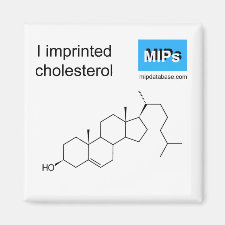
Authors: Wang SF, Xu JW, Tong YJ, Wang L, He CB
Article Title: Cholesterol-imprinted polymer receptor prepared by a hybrid imprinting method.
Publication date: 2005
Journal: Polymer International
Volume: 54
Issue: (9)
Page numbers: 1268-1274.
DOI: 10.1002/pi.1841
Abstract: A novel cholesterol-imprinted polymer (CMIP-H) was prepared by a hybrid method of covalent imprinting and non-covalent imprinting. This approach involves the copolymerization of a template-containing monomer, cholesteryl 2-hydroxyethyl methacrylate carbonate, and a cross-linker, followed by hydrolysis to afford a flexible guest-binding site accompanied with the easy and efficient removal of a 'sacrificial spacer'. The effect of solvent on the binding capacity of CMIP-H towards cholesterol was studied, indicating that a good binding capacity towards cholesterol could be achieved in a less-polar solvent. The binding experiments of CMIP-H towards a series of structural analogues of cholesterol, including cholesterol acetate, progesterone and stigmasterol, were carried out in hexane. The results showed that CMIP-H almost did not bind cholesterol acetate at all because the hydrogen-bonding site is blocked. It exhibited a similar binding towards both cholesterol and stigmasterol, but much higher binding towards progesterone. (c) 2005 Society of Chemical Industry
Template and target information: cholesterol, progesterone
Author keywords: molecular imprinting, sacrificial spacer method, cholesterol receptor



Join the Society for Molecular Imprinting

New items RSS feed
Sign-up for e-mail updates:
Choose between receiving an occasional newsletter or more frequent e-mail alerts.
Click here to go to the sign-up page.
Is your name elemental or peptidic? Enter your name and find out by clicking either of the buttons below!
Other products you may like:
 MIPdatabase
MIPdatabase









